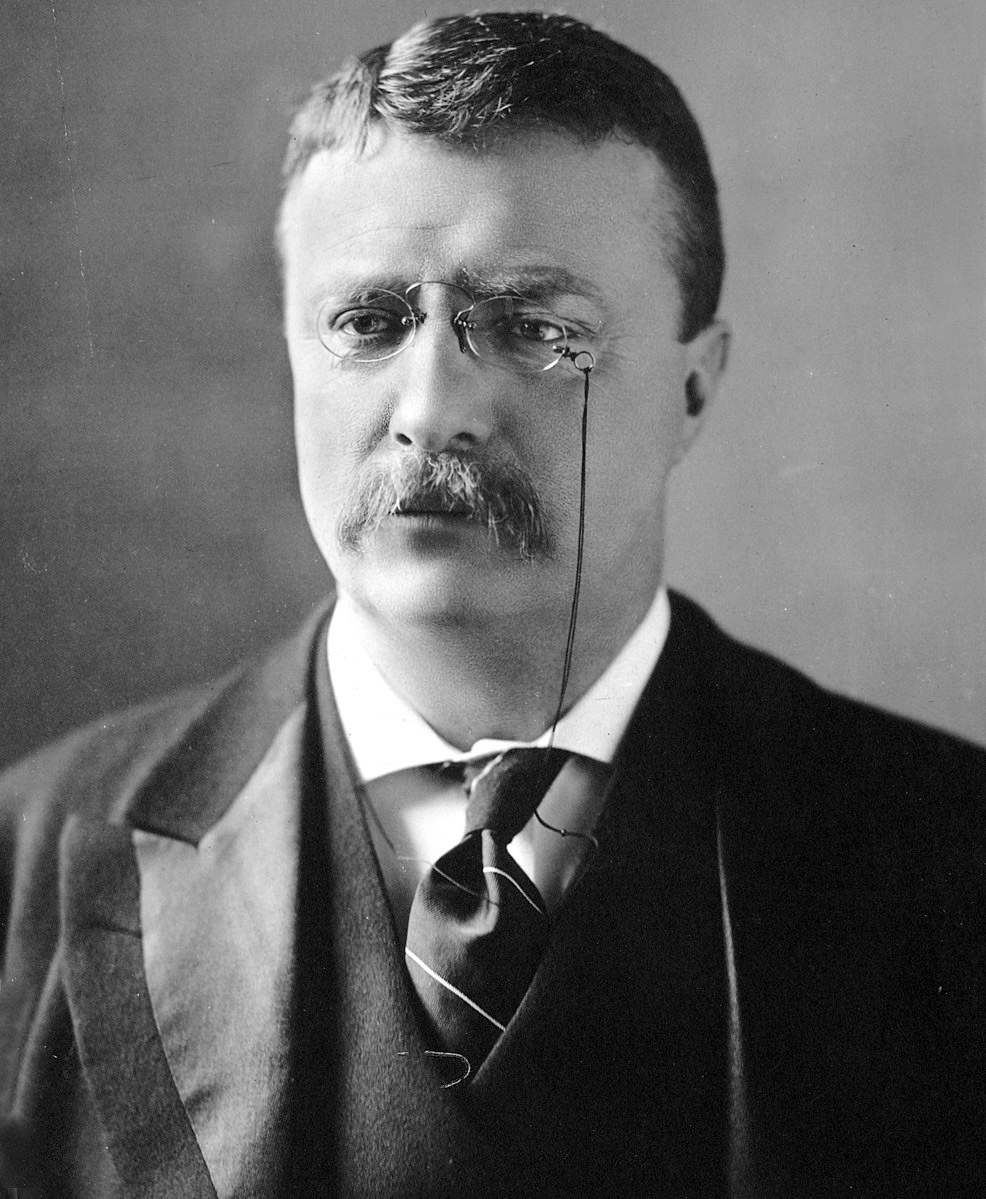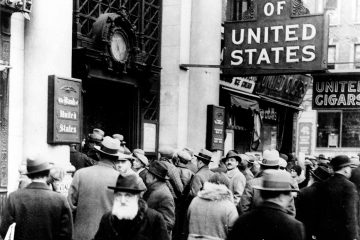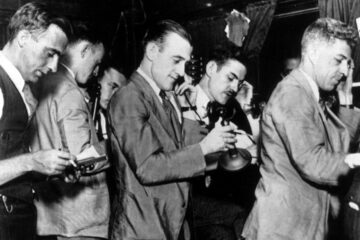What Happened in Business: 1902
| « 1901 | 1903 » |
 Summary: Growth Year ꜛ
Summary: Growth Year ꜛ
U.S. President: Theodore Roosevelt
DJIA End of Year Close: 46.63
Top Stocks: United States Steel Corporation, American Tobacco Company, American Sugar Refining Company*
Media: Newspaper, Mail, Magazine, Telegraph, Posters, Catalogs, Typewriters, Photography, Some Telephone
Wealthiest American: John D. Rockefeller
U.S. Population: 76.09 million (est)
Era: Progressive Era (1890s–1920s)
Key Events & Dates
Northern Securities Company Dissolution Begins – 1902:
The short-lived American railroad trust formed in 1901 by E. H. Harriman, James J. Hill, J.P. Morgan and their associates controlled the Northern Pacific Railway; Great Northern Railway; Chicago, Burlington and Quincy Railroad; and other associated lines. It was capitalized at $400 million, and Hill served as president. The company was sued in 1902 under the Sherman Antitrust Act of 1890 by the Justice Department under President Theodore Roosevelt,
Coal Strike of 1902 – May 12 – October 23:
One of the largest strikes by the United Mine Workers of America, it led President Roosevelt to intervene in a labor dispute for the first time, setting a precedent for federal involvement in labor issues.
Ford Motor Company Founded – June 16, 1903:
While officially founded in 1903, Henry Ford started developing his first automobile models in 1902, laying the groundwork for the future of the automotive industry.
First Cadillac Automobile Produced – October 17, 1902:
The Cadillac Automobile Company, founded in 1902, manufactured its first car, contributing to the growth of the luxury automobile market.
First American Film Theater Opens – June 19, 1902:
Thomas Tally opened the Electric Theater in Los Angeles, one of the first permanent cinemas in the United States, marking the beginning of the film industry.
Establishment of the U.S. Reclamation Service – June 17, 1902:
The U.S. Reclamation Service (now the Bureau of Reclamation) was created to manage water resources and support irrigation projects in the Western U.S., benefiting agriculture and industry.
Founding of the United States Steel Corporation – February 25, 1901:
Although officially formed in 1901, the consolidation of major steel companies under U.S. Steel continued to have a significant impact on the steel industry in 1902.
New York Stock Exchange (NYSE) Expands – 1902:
The NYSE experienced growth and increased trading activity during the year, reflecting its importance in U.S. business and finance.
Founding of the United Shoe Machinery Corporation – 1902:
The United Shoe Machinery Corporation was established, providing machinery and equipment to the growing shoe manufacturing industry.
Establishment of the Federal Bureau of Investigation (FBI) – July 26, 1908:
While not in 1902, the future FBI’s predecessor, the Bureau of Investigation (BOI), was created under the Department of Justice, impacting law enforcement in business matters.
Start of the Cadillac Automobile Company – August 22, 1902:
The Cadillac Automobile Company was founded in Detroit, Michigan, becoming a prominent name in the early automotive industry.
Continued Growth of the American Tobacco Company – Early 1900s:
The American Tobacco Company continued to expand its dominance in the tobacco industry through acquisitions and mergers.
Expansion of the Singer Manufacturing Company – Early 1900s:
The Singer Manufacturing Company, known for sewing machines, continued to grow and innovate, impacting the textile and manufacturing sectors.
Willis Carrier Invents Air Conditioning – July 1, 1902: This invention had a profound impact on living and working environments, eventually becoming ubiquitous in modern life.
Introduction of the Teddy Bear – February 2, 1902: The launch of the teddy bear, which became an iconic toy and spurred growth in the toy industry.
First Rose Bowl Game – January 1, 902:
The first postseason college football game, later known as the Rose Bowl, was played, marking the beginning of a new era in American sports and culture.
U.S. Economic Landscape in 1902
In 1902, the United States was in the midst of a significant economic transformation, characterized by rapid industrialization and the emergence of large corporations. This period at the end of the Gilded Age was marked by both tremendous economic growth and stark social inequalities. Here’s an overview of the U.S. economic landscape in 1902:
Industrial Expansion
Rise of Big Business: The economy was dominated by large businesses and monopolies, especially in industries like steel, oil, and railroads. The formation of U.S. Steel Corporation by J.P. Morgan in 1902, creating the world’s first billion-dollar corporation, exemplified this trend.
Technological Advancements: Innovations in technology and manufacturing, including the expansion of the railroad network and advancements in steel production, greatly boosted industrial productivity.
Labor Movement
Working Conditions: The average American worker faced long hours, low wages, and unsafe working conditions. Child labor was also prevalent.
Rise of Labor Unions: Labor unions gained momentum, fighting for better wages, hours, and working conditions. The Coal Strike of 1902 was a notable example, where President Theodore Roosevelt intervened in a labor dispute for the first time.
Agriculture
Agricultural Sector: While industry was booming, agriculture remained a significant part of the economy. Many Americans still lived and worked on farms, although the sector faced challenges like falling prices and debt.
Rural to Urban Migration: There was a significant migration from rural areas to cities, as people sought jobs in factories and industries.
Financial Sector
Banking and Finance: The financial sector was becoming increasingly important, with Wall Street emerging as a center of finance. The expansion of the Dow Jones Industrial Average in 1902 reflected the growing complexity of the American stock market.
Lack of Federal Regulation: The financial system lacked the federal regulation that would come later, leading to frequent speculation and economic instability.
International Trade and Expansion
Foreign Trade: The U.S. was transitioning from a debtor to a creditor nation, with increasing international trade. The country was beginning to assert itself more on the global stage.
Imperial Expansion: The U.S. was also involved in overseas expansion, as reflected in the ongoing efforts to build the Panama Canal, which would significantly impact global trade routes.
Social and Economic Disparities
Wealth Inequality: This era was marked by extreme wealth among industrialists and financiers, contrasted with widespread poverty among the working class.
Social Reform Movements: In response to these disparities, various social reform movements began to emerge, laying the groundwork for Progressive Era reforms.
Urbanization
Growth of Cities: Rapid urbanization was taking place, with cities growing as centers of commerce, industry, and culture. This brought about challenges such as overcrowding and sanitation issues.
The economic landscape of the U.S. in 1902 was thus a complex and rapidly changing one, setting the stage for many of the financial, industrial, and social developments of the 20th century.
Consumer Brands of the Era
In the year 1902, the United States had several consumer brands that were either established or gaining prominence. Here are a few notable consumer brands from that era:
Coca-Cola: Coca-Cola, the iconic soft drink, was already gaining popularity in the United States. The Coca-Cola Company had been founded in the late 19th century, and the beverage was being sold in bottles by 1902.
Ivory Soap: Procter & Gamble’s Ivory Soap was a well-known brand of soap in 1902. It was promoted as a pure and gentle soap, and its marketing emphasized its purity.
Quaker Oats: The Quaker Oats Company was manufacturing and selling oatmeal and other cereal products. Their brand featured the famous image of the Quaker Oats man on its packaging.
Hershey’s Chocolate: Milton Hershey had founded the Hershey Chocolate Company in the late 19th century. By 1902, the company was producing Hershey’s milk chocolate bars and other confectionery products.
Kellogg’s Corn Flakes: While the Kellogg Company had been founded earlier, it was in the early 1900s that they introduced Kellogg’s Corn Flakes as a breakfast cereal option.
Arm & Hammer: Arm & Hammer, known for its baking soda, was already a recognized brand in households across the United States. Baking soda had a variety of uses, including for cleaning and cooking.
Jell-O: The Jell-O brand, offering various flavored gelatin desserts, was growing in popularity during this time period.
Heinz: H.J. Heinz Company, known for its ketchup and other condiments, had been in operation for several decades by 1902 and was a trusted brand in American kitchens.
Kodak: The Eastman Kodak Company had already established itself as a leader in the photography industry, making cameras and photographic equipment accessible to the public.
These brands reflect the changing consumer landscape of the early 20th century, with an emphasis on convenience, purity, and new food and household products. Many of these brands have continued to thrive and evolve over the decades, becoming household names in the United States and beyond.
Key Leaders, Innovators, & Influencers of the Era
In 1902, the American business landscape was dominated by a group of influential industrialists and entrepreneurs whose activities and innovations played a crucial role in shaping the U.S. economy. Here are some of the most important business leaders and influencers of that era:
John Pierpont Morgan (J.P. Morgan):
A dominant figure in American finance, J.P. Morgan was a banker who arranged the merger creating the United States Steel Corporation in 1902. He was influential in several industries, including railroads and steel, and played a key role in stabilizing financial markets during economic crises.
Andrew Carnegie:
Although he sold his steel business to J.P. Morgan in 1901, forming the basis of U.S. Steel, Carnegie remained a highly influential figure in the business world in 1902. He was known for his philanthropy and his role in the expansion of the American steel industry.
John D. Rockefeller:
As the head of Standard Oil, Rockefeller was the most prominent figure in the American oil industry and one of the richest individuals in history. His business practices set standards in the industry and he was a key player in the rise of corporate monopolies.
Henry Ford:
While Ford Motor Company was founded in 1903, Henry Ford was already a significant figure in the automotive industry in 1902 due to his work on the assembly line and automobile design. His ideas would soon revolutionize manufacturing and transportation.
George Westinghouse:
An inventor and industrialist, Westinghouse was a major figure in the electrical industry. His company, Westinghouse Electric Corporation, was a key rival to Thomas Edison’s electric companies.
Thomas Edison:
Although more known for his inventions, Edison’s business ventures, especially in electricity (General Electric, which he co-founded, was formed in 1892), had a significant impact on American industry and innovation.
Cornelius Vanderbilt II:
Representing one of America’s wealthiest families, Vanderbilt was a key figure in the railroad and shipping industries. Although he passed away in 1899, his influence and business empire continued to shape these sectors in 1902.
James Buchanan Duke:
An influential tobacco industrialist, Duke played a significant role in the American tobacco industry. In 1902, he was actively involved in the expansion and modernization of his business enterprises.
Charles M. Schwab:
Schwab was a steel magnate who became president of U.S. Steel in 1901 before founding Bethlehem Steel in 1904. He was a key figure in the steel industry during this period.
Gustavus Swift:
As the founder of Swift and Company, Gustavus Swift was an important figure in the American meatpacking industry. His innovations in refrigerated railcars revolutionized the meat business.
These individuals were not just leaders in their respective industries but also played significant roles in shaping the modern American economy and business practices. Their influence extended beyond their companies, affecting broader economic policies, labor relations, and technological advancements.
* Stocks are examples of some of top, popular traded stocks; however, exact data not available.
| « 1901 | 1903 » |


